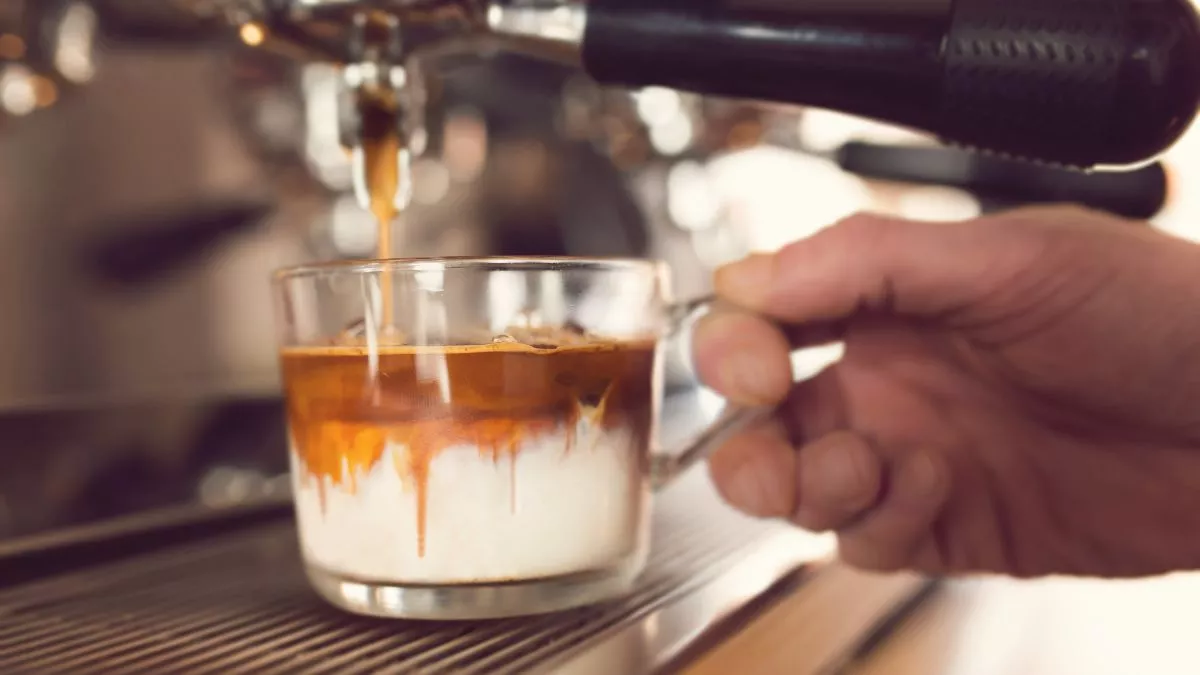
Espresso has quite some meanings in the Italian dictionary. For instance, the word espresso itself is Italian for special delivery, quick, or even made-to-order.
Espresso with creamer?
You can definitely mix espresso with creamer. It certainly adds a sweet flavor to it since the cream blends perfectly with the coffee’s bitter notes, giving off a deep-textured, yet balanced taste.
Espresso with creamer Name
Espresso with creamer doesn’t really have a specific name per se. Whether you’re making a latte, cappuccino, macchiato, or flat white; Milk can always be substituted for creamer. In fact, creamer can even be frothed to achieve your best-tasting, creamy-textured beverage.
That said, Espresso with cream or whipped cream is generally referred to as Espresso Con Panna.
Espresso Con Panna
Espresso Con Panna is the Italian word for espresso with cream, and it’s quite popular in Europe and in many parts of the world. This drink contains one or two shots of espresso topped with a load of cream (Not Creamer).
Originally, the drink contained one shot of Espresso and a couple of tablespoons of whipped cream. However, I’d suggest adding two shots of espresso with a greater amount of cream to make yourself a bigger, fuller drink.
How Much Coffee Creamer to Add?
Although creamers are added to coffee to enrichen its taste, I’d recommend not adding more than two tablespoons of creamer to your coffee.
This mainly has to do with the high levels of sugar or sweeteners in it. So, a couple of tablespoons can do the trick and improve the taste.
Latte With a Creamer
Coffee creamers come in a range of flavors that addresses the needs of everyone. Their sweetness helps dial down the bitterness of your coffee and provides a balanced flavor. Originally, a Latte is made by adding steamed milk to a shot of espresso.
A latte with creamer is made by substituting steamed milk with coffee creamer. This enriches the flavor and sweetens the base of an espresso shot. The different flavors of creamers provide you with a completely new and different flavor.
Iced Espresso with Creamer
Similar to iced coffee, iced espresso is a shot of espresso that is served with ice. Some drink an Iced Espresso just as it’s meant to be: on ice. Whilst, others prefer adding creamer to it. You can consume it either way depending on how you like your iced coffee. If you happen to add creamer to an Iced Espresso, you’d be greeted with a light, velvety coffee that provides a strong energy boost and carries the sweetness from the creamer.
Espresso Coffee Facts
Simply put, espresso involves running a small proportion of extremely hot water through the finely-ground coffee at an immense amount of pressure.
The pressure then forces out a warm honey-like consistency of coffee. The result is a thick and rich-bodied liquid with a thin layer of foam sitting on top of it, otherwise known as crema.
In comparison to other coffee brewing methods, Espresso is thicker and packed with a very strong, rich, and concentrated flavor. Now let’s see what exactly an espresso tastes like.
Espresso Layers
An Espresso shot contains three layers:
- Dark bottom layer (also known as the heart of an espresso). This layer holds all the bitter notes in your cup of espresso.
- The light brown middle layer (the body of an espresso). This layer defines a cup of espresso and indicates how well the ground coffee’s sweet texture was extracted.
- The thin top layer with a golden-brown layer of foam (also known as the crema). This layer adds aroma to an entire shot of espresso.
Together, these three layers combine to give off that bitter-sweet taste with a strong aroma of the espresso.
Espresso Taste
Although some people prefer to remove the top layer of crema from their coffees, I suggest otherwise. Espresso should be consumed with all three layers to provide that mixture of flavor in every sip. Only then can you get the most out of Espressos. Consider it more of a journey.
The crema on top provides a perfect blend of bitter, sour, and sweet notes. The first sip is like a sharp bite on the tongue. Not an icky type of bite, but an alerting one. A bite that makes you alert.
Also, the first sip should give off a rich and heavy, yet smooth texture that lingers on for a few minutes in your mouth.
Then, as you gulp down the rest of the espresso, you are greeted with a range of colorful flavors depending on the (ground) coffee bean flavors.
However, some espressos and coffees may taste bitter, which is not because of the grind size or the roast type, but because of poor extraction of beans. No coffee is meant to taste sour.
Differences Between Coffee & Espresso
One of the main differences between coffee and espresso is the process by which Espresso is prepared. There are a number of processes through which normal coffee can be brewed (for instance French press, percolator, siphon pot). However, espresso can only be brewed from an espresso machine.
In the same manner, you can’t use espresso roast grounds in other coffee-brewing methods like French press or pour-over. Otherwise, you’d just be getting a bland, very sour cup of coffee/espresso.
Espresso shots are smaller in size, hence packing comparatively less caffeine amount as compared to the amount of caffeine found in a cup of coffee. Though there is a greater amount of concentrated caffeine per ounce in the former.
Unlike a typical cup of coffee, a freshly-brewed espresso shot does not consist of a range of other ingredients. A typical coffee is mixed with a number of things that helps bring out its different flavors. Therefore, there is a difference in the taste and consistency of both drinks.
Coffee Creamer Facts
Creamer is a product used to sweeten and lighten your coffee. They are available in two forms – powder and liquid. Mostly, coffee creamers are found to be dairy-free which means that they are free from even a hint of milk or milk-related items. This is the reason why these coffee creamers are usually known as coffee whiteners.
In almost all cases, you’d find coffee creamers to be made up of unhealthy ingredients. For instance, sugar, thickeners, oils, and even artificial sweeteners. That being said, most companies are making efforts and carrying out research in order to produce healthier creamers.
Powdered creamers, unlike liquid creamers, have a longer shelf life and do not need to be refrigerated.
However, once you open a liquid creamer can, the clock starts ticking. Eventually, the creamer starts to lose its value (and content) leaving you with a bland and moldy creamer that smells bad.
This is why liquid creamers need to be used quickly compared to powdered creamers that can be stored for a longer time.
Final Thoughts
Over the years, a number of different coffee types and flavors have surfaced; from different coffee machines to newer coffee brewing methods, there are always new additions to an ever-growing menu. Among these coffee types, is the infamous Espresso.
We read the different types of beverages that can branch out from espresso. We read the number of variations that can be done to espresso to create unique and equally-tasty flavors and drinks.
Most of these drinks contain a good amount of milk mixed with espresso. Although the calories in all these drinks are somewhat higher, they do not come from a completely unnatural source.
Coffee creamers are manufactured using artificial materials which are not beneficial for health and might also become harmful to health in the long term. However, if someone HAS developed a taste for espresso creamers, I’d highly recommend controlling the amount of creamer that goes in your cup of coffee.
It all started in the early 20th century when an Italian businessman – and an owner of a manufacturing factory – came up with the idea of brewing coffee quickly. Put short, this led to the invention of the Espresso machine.
I hope you enjoyed this article! If you did, please share with other coffee lovers!
